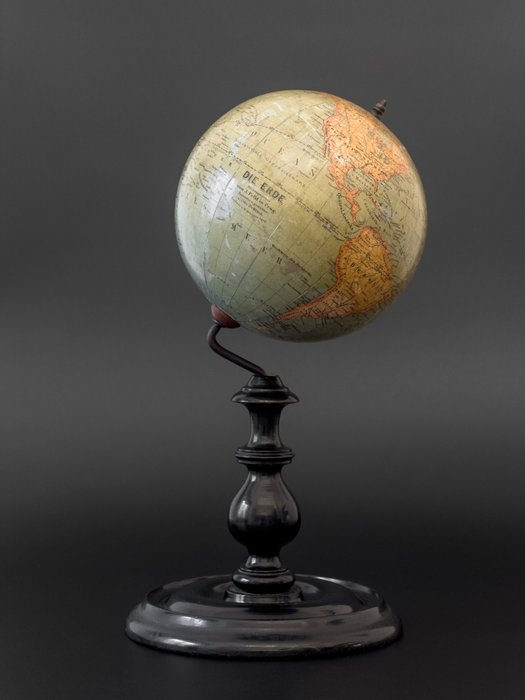
宗教和精神物品 -
編號 82050403

編號 82050403

Terrestrial Globe by J. Felkl / designed Otto Delitsch, Prague Leipzig, c. 1870
Rare globe published by J. Felkl, it was produced when the company was still managed by J. Felkl alone, later the company changed its name and became J. Felkl & sohn
The globe is well preserved, it has signs of aging and a small dent, the colors are bright and well defined, the cartography is very legible.
The globe is mounted on a black painted wooden turned stand with ergonomic shape typical for Felkl globes, which was used well into the 20th century.
The globe has a beautiful patina!
Diameter: c. 16 cm
Height: c. 34 cm
German language
_____________________________
Jan Felkl (1817-1887) was born in Bohemia but moved to Prague in early adulthood where he worked in the postal office. In 1850 he acquired the Vaclav Merklas globe manufactory in Prague and in 1854 started globe-production under his own name. The cartography for these globes had been developed by Felkl himself, in collaboration with Professor Otto Delitsch of Leipzig University.
He soon became the largest producer of globes in the Austro-Hungarian Empire, with spheres of diameter 6.2, 8.6, 11.4, 15.8, 21.9, 31.9 and 47.5cm. diameter, in any of 17 different languages. He also produced telluria, lunaria and other planetaria as well as wall maps for schools and offices. His proficiency and and productivity were in part a result of a law that decreed that all schools throughout the Austro-Hungarian had to have a globe. Most of these were supplied by Felkl. By 1855 the company had produced 800 globes; in 1873 alone they produced 15,000.
In 1870, due to the poor state of Jan's wife's health, the company moved location to Roztoky near Prague, and it was there that Jan's son Christoph Siegmund (1855-1894) was made a partner in the firm in 1875, at the age of 20. Christoph Siegmund was the fifth of Felkl's nine offspring and his youngest son. Siegmund, as he was known, was regarded as an eccentric character, and none too popular with his employees; he is recorded as having kept a human skeleton standing by his bedside holding a candlestick, and a human skull on his desk as a repository for his pens.
Following Siegmund's unexpected death on a business trip in Munich in 1894, the company was run by Jan's second child and second eldest son Ferdinand (1846-1925). He was reportedly more popular than his brother, and ran the factory with greater efficiency. The firm stopped work for seven years during the First World War until starting up again in 1921 at the instigation of Czech economist Professor Albin Bráf; until the enforced hiatus they had been supplying mainly to Vienna, the Netherlands, Russian Poland and Russia, and had won awards at exhibitions in Prague in 1895 and 1908. But they would never again reach again the heights of commercial success they enjoyed in the second half of the nineteenth century and the company ceased production in 1954, going into liquidation two years later.
The images were taken professionally and highlight the actual state of conservation of the item. The globe retains its original state and has not been restored.